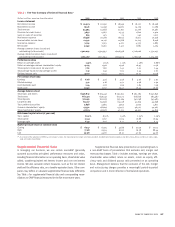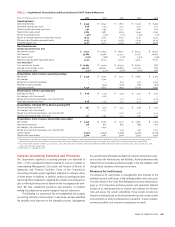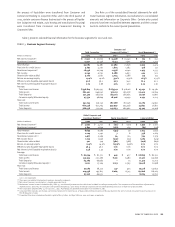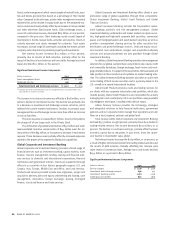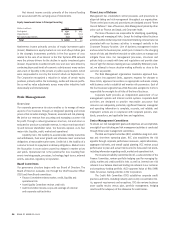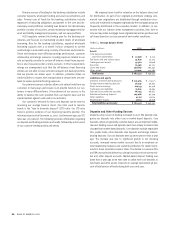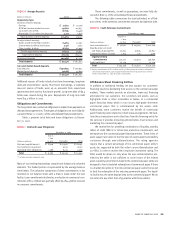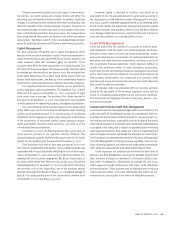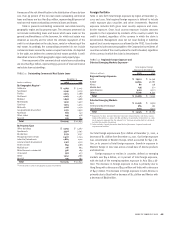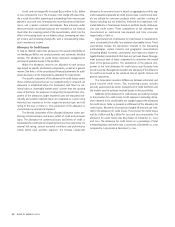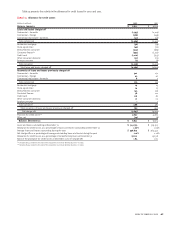Bank of America 2002 Annual Report Download - page 39
Download and view the complete annual report
Please find page 39 of the 2002 Bank of America annual report below. You can navigate through the pages in the report by either clicking on the pages listed below, or by using the keyword search tool below to find specific information within the annual report.
BANK OF AMERICA 2002 37
Risk Management Controls
We use various controls to manage risks at the line of business level and
corporate-wide. For example, our planning and forecasting process facil-
itates analysis of results versus plan and provides early indication of
unplanned risk levels. Various line of business risk committees and
forums are comprised of line personnel, Risk Management and other
groups responsible for the internal control infrastructure (i.e. Finance,
Legal, Compliance, Tax and/or Corporate Audit). Limits, the amount of
exposure that may be taken in a product, relationship, region or indus-
try, are set based on metrics thereby aligning our risk goals with those
of each line of business. Models are used to estimate market and net
interest income sensitivity. Modeling is used to estimate both expected
and unexpected credit losses for each product and line of business. We
employ hedging strategies to reduce concentrations and improve port-
folio granularity and to manage interest rate risk in the portfolio. We
have continued to strengthen the linkage between the associate per-
formance management process and individual compensation to help
associates work toward corporate wide goals. Finally, compliance plays
a significant role in aiding our business units in risk management.
Formal processes used in managing risk only represent one
side of the equation. Corporate culture and the actions of our associ-
ates are critical to effective risk management. Through our recently
updated Code of Ethics, we set a high standard for our associates.
The Code of Ethics provides a framework for all of our associates to
conduct themselves with the highest integrity in the delivery of their
product or service to our customers.
The following sections, Liquidity Risk Management, Credit Risk
Management beginning on page 41, Market Risk Management begin-
ning on page 49 and Operational Risk Management beginning on page
53, address in more detail the specific procedures, measures and
analyses of the four categories of risk that we manage.
Liquidity Risk Management
Liquidity Risk
Liquidity is the ongoing ability to accommodate liability maturities and
withdrawals, fund asset growth and otherwise meet contractual obli-
gations through generally unconstrained access to funding at reason-
able market rates. Liquidity management involves maintaining ample
and diverse funding capacity, liquid assets and other sources of cash
to accommodate fluctuations in asset and liability levels due to busi-
ness shocks or unanticipated events.
We manage liquidity at two primary levels. The first level is the
liquidity of the parent company, which is the holding company that
owns the banking and non-banking subsidiaries. The second level is
the liquidity of the banking subsidiaries. The management of liquidity
at both levels is essential because the parent company and banking
subsidiaries each have different funding needs and sources and each
are subject to certain regulatory guidelines and requirements. The
Finance Committee is responsible for establishing our liquidity policy
as well as approving operating and contingency procedures and
monitoring liquidity on an ongoing basis, both of which may be del-
egated to ALCO. Corporate Treasury is responsible for planning and
executing our funding activities and strategy.
A primary objective of liquidity risk management is to provide a
planning mechanism for unanticipated changes in the demand or need
of liquidity created by customer behavior or capital market conditions.
In order to achieve this objective, liquidity management and business
unit activities are managed consistent with a strategy of funding stabil-
ity, flexibility and diversity. We emphasize maximizing and preserving
customer deposits and other customer-based funding sources. Deposit
rates and levels are monitored, and trends and significant changes are
reported to ALCO and the Finance Committee. Deposit marketing
strategies are reviewed for consistency with our liquidity policy objec-
tives. Asset securitization also enhances funding diversity and stability
and is considered a critical source of contingency funding.
We develop and maintain contingency funding plans that sepa-
rately address the parent company and banking subsidiaries liquidity.
These plans evaluate market-based funding capacity under various
levels of market conditions and specify actions and procedures to be
implemented under liquidity stress. Further, these plans address
alternative sources of liquidity, measure the overall ability to fund our
operations and define roles and responsibilities for effectively manag-
ing liquidity through a problem period.
Our borrowing costs and ability to raise funds are directly
impacted by our credit ratings and changes thereto. The credit rat-
ings of the Corporation and Bank of America, N.A. are reflected in
the table below.
TABLE 4 Credit Ratings
Bank of America Corporation Bank of America, N.A.
Commercial Senior Subordinated
Paper Debt Debt Short-Term Long-Term
Moody’s P-1 Aa2 Aa3 P-1 Aa1
S & P A-1 A+ A A-1+ AA-
Fitch, Inc. F1+ AA- A+ F1+ AA
Primary sources of funding for the parent company include dividends
received from its banking subsidiaries and proceeds from the
issuance of senior and subordinated debt, commercial paper and
equity. Primary uses of funds for the parent company include repay-
ment of maturing debt and commercial paper, share repurchases,
dividends paid to shareholders and subsidiary funding.
Parent company liquidity is maintained at levels sufficient to fund
holding company and non-bank affiliate operations during various
stress scenarios in which access to normal funding sources is dis-
rupted. The primary measure used in assessing the parent company’s
liquidity is “Time to Required Funding” in a stress environment. This
measure assumes that the parent company is unable to generate
funds from debt or equity issuance, receives no dividend income from
subsidiaries, and no longer pays dividends to shareholders. Projected
liquidity demands are met with available liquidity until the liquidity is
exhausted. Under this scenario, the amount of time which elapses
before the current liquid assets are exhausted is considered the Time
to Required Funding. ALCO approves the target range set for this
metric and monitors adherence to the target. In order to remain in the
target range, management uses the Time to Required Funding meas-
urement to determine the timing and extent of future debt issuances
and other actions.


